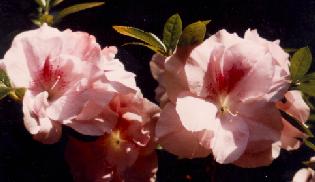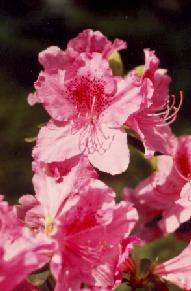Parents of an Azalea Hybrid Cross
 Nancy of Robin Hill |

Dream |
Since I spend much of my spare time at Jefferson, I enjoyed reaching out to students who share my interest in plants. Jefferson has an activity period, a regular part of the school day where students can attend clubs of all different types. After Chuck retired, I decided to form a Plant Preservation Club. Although interested in preserving all sorts of rare plants, we naturally focused our efforts on rhododendrons since that has been a hobby of mine since early childhood. With seeds of native azaleas and rhododendrons collected wild in West Virginia sent to me by several members of the American Rhododendron Society, and a few hybrid crosses of my own, we were on our way.
 Nancy of Robin Hill |

Dream |
Initially, I tried to work with ninth graders since they could experience the full cycle: sowing seed, raising plants, and watching them bloom during their four years of high school. I also wanted to stress organic principles and environmental concerns through all phases of the project. We used recycled gallon plastic milk jugs for seedling containers and filled them with a potting mixture of peatmoss, sand, and perlite. After scattering the seeds over the top, we enclosed the containers in clear plastic bags, and placed them in the corner of our computer lab under an inexpensive fluorescent light fixture.
Throughout the school year, we watched the rhododendrons grow and transplanted crowded seedlings into other jugs as time and space permitted. One advantage of growing seedlings in these mini- greenhouses is that they require no care for months at a time, making it a perfect project in a busy classroom. When I met with the students, we would shake condensation off the plastic bags and peer at the plants developing inside. We talked about differences in foliage characteristics, speculated on native environments, and wondered about the possibilities for some of the hybrid crosses.
When warm weather arrived, we moved most of the plants outside along a northeast wall of an interior courtyard, but kept the smaller seedlings back in our computer lab, still enclosed in plastic bags. When rain was not sufficient during summer months, I stopped by to water the container plants and made sure the fluorescent lights were still burning. As winter approached, we mulched the outdoor area with leaves gathered around the school campus and let nature take its course.
During the next two years, we watered, fertilized, and transplanted seedlings to larger pots, awaiting those first flower buds. We also planted more seeds. There were predictable droughts, heat waves, heavy snows, fungus diseases, and insect pests, but we never sprayed or tried to maintain artificially perfect conditions. Wanting to rely on natural selection to help reduce the numbers, we still had more seedlings than we could manage.